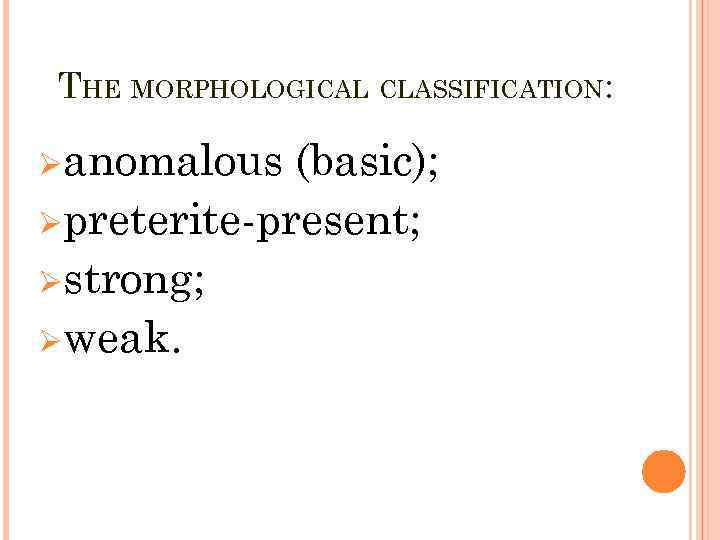
THE VERB in Old English

LECTURE OUTLINE 1. The morphological classification. 2. Verbal stems. 3. Syntax. 4. Vocabulary. 5. Middle English historical background. Orthography.

THE MORPHOLOGICAL CLASSIFICATION: Øanomalous (basic); Øpreterite-present; Østrong; Øweak.

STRONG VERBS Historically they are the oldest in OE ≈ 300 years; Proto-Germanic origin; use ablaut (vowel interchange) to indicate the tense.

Subdivided into 7 classes on the basis of the differences of vowel gradation; Class 1 and 3 were the most numerable; Class 2 included ≈ 40 verbs; strong verbs in Modern English are irregular verbs.

CLASS 1 Infinitive Past (singular) wrītan wrāt (NE “write”) Past (plural) writon Past participle written CLASS 3 singan sang (NE “sing”) sungon sungen

WEAK VERBS Number is constantly growing; q use dental suffix -de in the singular and -don in the plural; q derivatives from OE nouns and adjectives. q

Divided into 3 classes, depending on the endings of the infinitive and the sound preceding the suffix: Class 1 verbs end with -an or -rian. Class 2 -ian (except -rian). Class 3 verbs often combine features of the first two classes. q

PRETERITE-PRESENT VERBS Combine the qualities of both strong and weak verbs: 1) Present tense is formed according to rules of the strong verbs; 2) Past tense like weak verbs have; 12 of them in OE. 6 of them are Modern English modal verbs.

“know how to” “be obliged to” cunan sculan 1 can sceal 2 canst scealt 3 can sceal cunnon sculon 1 cuðe sceolde 2 cuðest sceoldest Past(plural) cuðon sceoldon Participle cuð − Infinitive Present(singular) Present(plural) Past (singular)

ANOMALOUS VERBS “Basic” verbs (fundamental components of the language); o historically a blend of two or more different Germanic verbs; o only 4 of them: beon-wesan − be, dōn − do, зān − go, willan − will. o

VERBAL 1. 2. 3. STEMS The Present Tense stems; The Past Participle stems.

STRONG VERBS Infinitive Past (singular) cēosan cēas (NE “choose”) Past (plural) curon Past participle coren WEAK VERBS dēman dēmde (NE “dream”) dēmde dēmed

TO CONCLUDE OE verbs had such categories as tense, mood, number and person; Ø no future tense in OE; Ø all the verbs were divided into 4 big classes: weak, strong, anomalous and preteritepresent; Ø the above mentioned classes used different from-building means; Ø 3 sets of verbal stems in OE: The Present Tense stems, The past Tense stems; The Past Participle stems. Ø

OE SYNTAX OE was a synthetic language: it possessed a system of grammatical forms, which could indicate the connection between words; primarily a spoken language; relatively simple; no do-support in questions and negatives; multiple negation could intensify each other (negative concord).

SIMPLE SENTENCE Soðlice sum manne hæfde tweзen suna. Trully a certain man had two sons. • • The connection is shown by the word forms; some parts of the sentence can be omitted.

COMPOUND AND COMPLEX SENTENCE Existed since the earliest times; constructions were loosely connected, disordered; two parts were joined asyndetically (without any conjunction).

WORD ORDER ü The order of words in the OE sentence was relatively free; ü the position of words in the sentence was often determined by logical and stylistic factors; ü depends on the communicative type of the sentence: question vs. statement: Hwæt is þæs cyninge nama? (What is that king’s name? ); ü the subject in the subordinate clause is followed by the conjunction and ends with the predicative.

VOCABULARY ≈ 30 000 to 80 000 words; Etymology: most of the words are purely Germanic (native words inherited from PG or formed from native roots and affixes); word structure: 1) simple words (“rootwords”) зōd (NE “god”); 2) derived words: root-morpheme+ affixes beзinnan (NE “begin”); 3) compound words: more than one rootmorpheme: mann-cynn (NE “mankind”).

Ways of word-formation: affixation, sound interchange, word stress, word composition; polysemy (37 words denoting the concept of a warrior); kenning − is a compound word, that employs figurative language. Widely used in poetry: sǣ (NE “sea”) + mearh (NE “horse”)= sǣmearh (NE “ship”) bān (NE “bone”)+hūs (NE “house”)= bānhūs (NE “body”).

Ø OE was mostly spoken, not written; Ø multiple negation; Ø word order was relatively free; Ø most of the words in OE vocabulary were of native origin; Ø characteristic feature of poetic texts is kenning.